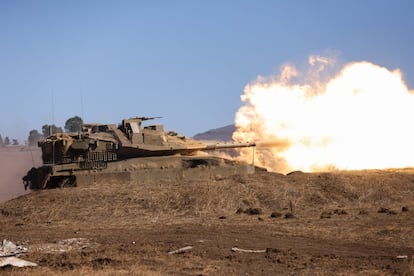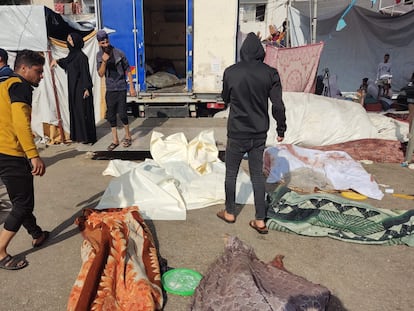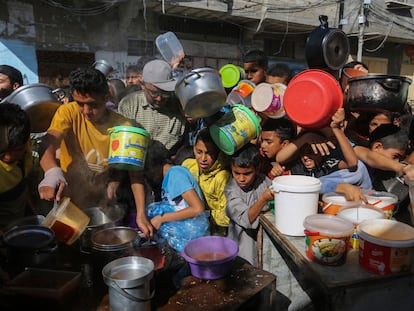Israel faces new fronts of attack in its war against Hamas
Five weeks since the start of the conflict, attacks on the country extend from the borders of Lebanon and Syria to the West Bank and the Red Sea


The fear that the war between Israel and Hamas in Gaza would spread across the region has become in part a reality. Five weeks after Hamas launched its attack on October 7, Israel is facing new fronts of attack beyond the Palestinian enclave, but within Israel’s borders. Benny Gantz, Israel’s former minister of defense and a current member of the emergency government, admitted that his country is now in a “multi-front war.”
“The main focus is on Gaza, but we are fighting in defense and offense in the north and other areas,” Gantz, who led in 2014 as chief of staff general the previous large-scale contest in the Strip, warned Tuesday at the Israeli Defense Forces (IDF) headquarters in Tel Aviv. His statements were made a month after the start of the war, which has killed 1,200 people in Israel and more than 11,000 in Gaza. The attacks against Israel, mostly by militias and armed groups linked with Iran, extend from the borders of Lebanon and Syria, to the West Bank and the Red Sea.
North Front
The escalation of the war on the Lebanese-Israeli border has opened the largest and most explosive front of hostilities after the conflict in the Gaza Strip. Since October 7, 90 people — 70 of them members of the pro-Iranian Hezbollah militia — have been killed in Lebanese territory. Exchanges of rocket fire from Shiite guerrillas and Israeli artillery on both sides of the Blue Line — which marks the dividing line between two countries that are still technically at war — are becoming more intense and more far-reaching every day. On Saturday, they reached an area located 28 miles north of the border, where an Israeli drone attacked a Lebanese vehicle.
Former Israeli general Yossi Kuperwasser, who was head of the IDF’s intelligence research division, believes that “the escalation on the Lebanon front is happening in a controlled manner.” “But as Israel infiltrates Gaza City, we are going to see more warlike confrontation on the Lebanese border,” he said on Thursday at a conference for foreign journalists in Jerusalem. In his opinion, “neither Israel nor Hezbollah seem willing to launch into a full-scale war,” as in 2006. That year, 1,300 Lebanese people, mostly civilians, and 165 Israelis, nearly all soldiers, were killed in 33 days of fighting. Subsequently, 10,800 U.N. peacekeepers from 40 countries were deployed to the border.
In his second address since the start of the war in Gaza, Hezbollah leader Hassan Nasrallah said Saturday that Iran “provides military, financial and diplomatic support.” “If the resistance is strong in Lebanon, Palestine and the region, it is thanks to the material, military and financial support from Iran,” he added. “This has brought about a shift in the balance of regional deterrence.” Nasrallah revealed that Hezbollah is attacking new targets in Israel, with an increase in the number of operations and type of weapons in recent days, and vowed that the Lebanon front “will remain active.”
“Hezbollah has to take into account what the rest of the Lebanese people are saying. They know that their country, mired in a severe economic crisis, could be devastated if a war with Israel breaks out. No one wants that,” argued Kuperwasser, who is also an expert on security issues at the Jerusalem Center for Public Affairs. “First and foremost,” he said, “Hezbollah is seeking to distract Israel from its fundamental objective against Hamas in the Gaza Strip.”
Other actors are also operating on the northern front, such as the Palestinian militias exiled in Lebanon, affiliated with both Hamas and the secular nationalist party Fatah. From Syria, on the border with the Golan Heights (the Syrian plateau occupied by Israel since 1967), the Quds Force, the expeditionary force of the Iranian Islamic Revolutionary Guard, is also playing a role. Further afield, Iraq’s Shiite militias are also attacking the bases from which the United States protects its allies in the Middle East, such as Israel.
Southern Front (Red Sea)
Nasrallah also said the “axis of resistance” was restraining Israel with “heroic containment,” in reference to the attacks by the Yemeni Houthi rebels against the southern tip of Israeli territory. “Israel has been forced to divert part of its air defense system to the Eilat area.”
Eilat is a popular tourist destination on the Gulf of Aqaba, where Israel has access to the Red Sea. Suicide drones and cruise and ballistic missile launches from Yemen have redoubled the threat of pro-Iranian forces against Israeli territory, precisely in an area where more than 60,000 Israeli civilians displaced by the war from areas bordering the Gaza Strip have been resettled.
Israel resorted for the first time to the new Arrow defensive system. This is the most advanced rocket shield it has, after the Iron Dome system (for short-range rockets) and the David’s Sling (medium range). The Houthis have claimed responsibility for the attacks, some of which have hit nearby Egyptian territory. From the Red Sea, Saudi Arabia and the U.S. are also shielding Israel from the attacks of the Yemeni rebels. The U.S. destroyer Carney, equipped with the Aegis anti-missile system, has intercepted several of the missiles and drones launched by the Houthis.
“We are facing a new type of multifront war,” said Kuperwasser. “But not all fronts are being fought with the same intensity. The main one is in Gaza, and the others, against Hezbollah or the Houthi militia, are secondary. We are present on the rest of the fronts, and with more forces than we usually deploy in normal times.”
This analyst believes that Iran’s allies have been exerting more pressure as part of “a simultaneous operation of the Shiite forces.” Kuperwasser says that Iran supplies arms and finances its militias, which have a “deep ideological commitment against Israel.”
West Bank Front
Israel has deployed soldiers on its borders with Lebanon and Syria, and in the waters of the Red Sea. At the same time, it has intensified its military presence in areas theoretically controlled by the Palestinian National Authority, in the West Bank, which has been occupied by Israel for 56 years. “The military deployment is very strong in the north, around Jenin,” said Kuperwasser.
Since October 7, at least 175 Palestinians have lost their lives at the hands of Israeli security forces or radical settlers. Before the attack by Hamas militias that triggered the war, some 220 Palestinians had lost their lives since the beginning of 2023, which was already the deadliest in the West Bank since the Second Intifada (2000-2005).
“Hamas has high expectations of expanding its influence in the West Bank, and among Israel’s Arabs [20% of the population of Palestinian origin], but these now remain calm,” he said.
Contrary to what happened during the Gaza war of 2021, the outbreak of violence in cities with a mix of Israeli Arabs and Israeli Jews, such as Lod or Haifa, has not been seen so far in the current conflict. In East Jerusalem, also under occupation since 1967, there have been at least three episodes of stabbings against security forces, in which one officer was killed and the attackers shot dead.
For Kuperwasser, the main question now is whether the Palestinian Authority — which Palestinians consider to be corrupt and weak against Israel — will in a possible future scenario, be able to take over the West Bank areas under its control amid the current climate of violence, and also assume control over the Gaza Strip.
Sign up for our weekly newsletter to get more English-language news coverage from EL PAÍS USA Edition
Tu suscripción se está usando en otro dispositivo
¿Quieres añadir otro usuario a tu suscripción?
Si continúas leyendo en este dispositivo, no se podrá leer en el otro.
FlechaTu suscripción se está usando en otro dispositivo y solo puedes acceder a EL PAÍS desde un dispositivo a la vez.
Si quieres compartir tu cuenta, cambia tu suscripción a la modalidad Premium, así podrás añadir otro usuario. Cada uno accederá con su propia cuenta de email, lo que os permitirá personalizar vuestra experiencia en EL PAÍS.
¿Tienes una suscripción de empresa? Accede aquí para contratar más cuentas.
En el caso de no saber quién está usando tu cuenta, te recomendamos cambiar tu contraseña aquí.
Si decides continuar compartiendo tu cuenta, este mensaje se mostrará en tu dispositivo y en el de la otra persona que está usando tu cuenta de forma indefinida, afectando a tu experiencia de lectura. Puedes consultar aquí los términos y condiciones de la suscripción digital.
More information
Archived In
Últimas noticias
The Bolsonaro surname: An advantage or liability in Brazil’s 2026 presidential elections?
Raúl Rocha, from jet-setting with Miss Universe to arms trafficking and fuel theft
80,000 barrels of Mexican oil sent to Cuba: Havana drawn into the US–Mexico clash
Human rights activists, opposition members, and a minor: Maduro’s other political prisoners
Most viewed
- Reinhard Genzel, Nobel laureate in physics: ‘One-minute videos will never give you the truth’
- Pablo Escobar’s hippos: A serious environmental problem, 40 years on
- Charles Dubouloz, mountaineering star, retires at 36 with a farewell tour inspired by Walter Bonatti
- Why we lost the habit of sleeping in two segments and how that changed our sense of time
- The fall of a prolific science journal exposes the billion-dollar profits of scientific publishing










































